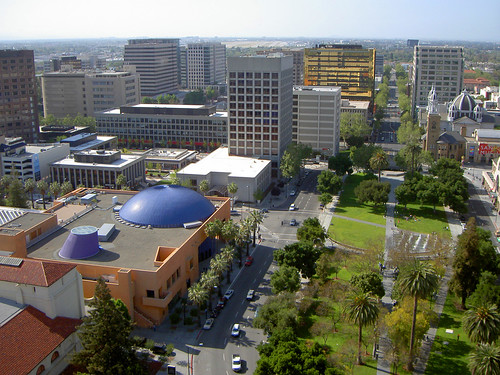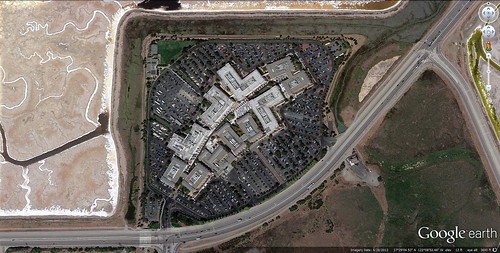Is there a way to (downtown) San Jose? (by Lee Epstein)

Posted May 6, 2013 at 1:32PM
Today’s post is written by my frequent collaborator and contributor to this site, Lee Epstein Lee is an attorney and land use planner working for sustainability in the mid-Atlantic region. His last appearance here was on April 3 (“The essential elements of green cities”).
I recently read Richard Florida’s account of San Jose, California on The Atlantic Cities (“Lessons from Silicon Valley’s ‘Downtown,’” April 5, 2013), and was prompted into some reflections of my own about the state of urban affairs, if they can be called that, around the city and its surroundings. I believe that, if the region is to fulfill its potential, some improvements are in order, and sooner rather than later.
But first, a caveat: I hesitate to jump into a geographic region that I only know as a tourist, and I wouldn’t presume to deeply analyze its problems or its promise. When I travel, I can – from a safe remove – describe what seems to be working or not working; but one can’t do too substantial an analysis without committing significant resources of time and effort, and spending real time on the ground.
That said, as a long-time urban planner, I’m reasonably familiar with the history of development across the Golden State. Indeed, some of the history of suburbanization there is the history of suburbanization everywhere in the US:
- The post-war growth of cities and towns generally;
- A wholesale emigration in the US from north to south and east to west, and residential and commercial movements out of established cities to the wide, open spaces outside them -- followed by civic buildings and major local institutions;
- Aging industrial facilities that attracted workers at one point, but then shed them too quickly at another;
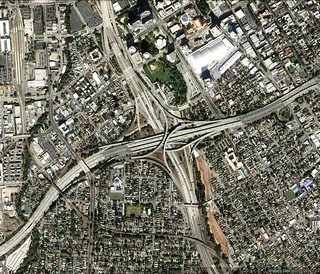 The development of the Interstate Highway System that allowed urban migrations and transformations at an immense speed and scale, literally plowing through, over and under whole urban neighborhoods, on the one hand, and helping to create the impetus for sprawl and sprawl-malls in the hinterlands, on the other; and,
The development of the Interstate Highway System that allowed urban migrations and transformations at an immense speed and scale, literally plowing through, over and under whole urban neighborhoods, on the one hand, and helping to create the impetus for sprawl and sprawl-malls in the hinterlands, on the other; and,- Most recently, the rise of the Cyber-Age, with its uncertain implications for the future of cities and brick-and-mortar retail.
Like many of its cousins elsewhere across North America, the urban region around San Jose is polycentric. In this instance, much major economic development and investment has occurred to the northwest, scattered in a chain of dozens of cities from Palo Alto up through San Francisco and Oakland, and around San Francisco Bay. But there is no doubt that “Silicon Valley” in highly urbanized Santa Clara County, is real – just ask one of its workers, looking for 1,500 square feet of living space in and around San Jose that doesn’t cost a mint’s worth of gold bars.
The big question, recently addressed in summary by Florida and in detail by SPUR, the Bay-area urban planning organization (“Shaping Downtown San Jose,” by Egon Terplan and Jason Su, in The Urbanist, April, 2013) is whether or how the City of San Jose can once again become the center of life and commerce it once was, many decades ago, when the County (now almost two million in population) was rather sleepy and agricultural.
Can the housing needed by those thousands of knowledge workers, noted above, be created downtown? Can some of the internet and tech companies that built their beloved, isolated corporate campuses northwest of San Jose – not unlike the land-wasting corporate “office parks” of the 1970’s and ‘80’s – be brought back into town?
For example, take a look at the Facebook “campus” in Menlo Park, above.
Not that the problem is unique to Facebook. This blog published several pieces (including this one) on Apple’s failure to think “community” when it designed and pushed its high-concept, “donut/spaceship” headquarters in Cupertino a couple years ago. (Fortunately, other high-tech companies are not as physically disconnected from their communities. For example, Amazon has opted for a creative, community-strengthening design for its headquarters in Seattle, and Zappo appears to be doing good work in Las Vegas.)
Is there a company that can make the kind of commitment to San Jose that Amazon has made to Seattle? While some firms such as Cisco and eBay reside in North San Jose, can some Silicon Valley firms be coaxed into downtown?
In addition to what the Silicon Valley companies may do as they consider the more urban future that their workers will seek, can San Jose at least moderately densify and, as SPUR’s recent report recommends, improve connectivity and urban continuity by filling in the gap-toothed interstices now represented by parking lots and one-story buildings? 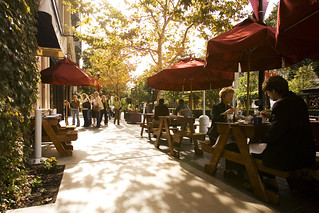 Importantly, can San Jose do this without losing the character and funky mix of ethnic eateries and small businesses which are there now, and keep or create a lively, active street-level scene? Can the city capitalize on and successfully brand some of the newer cultural and nightlife attractions it has managed to create? Can it work with its neighbors to limit further growth beyond the existing urban fringe?
Importantly, can San Jose do this without losing the character and funky mix of ethnic eateries and small businesses which are there now, and keep or create a lively, active street-level scene? Can the city capitalize on and successfully brand some of the newer cultural and nightlife attractions it has managed to create? Can it work with its neighbors to limit further growth beyond the existing urban fringe?
These are all tough questions, but the answers generally need to be “yes” to most or all of them in order to succeed. Florida has some good suggestions for moving the ball along, including these: changing the mindset that made San Jose and many medium-sized cities a terrific habitat for fast-moving cars, but awful for pedestrians (starting by converting streets back to a two-way system with parallel, on-street parking, and maybe tearing up some of those disruptive expressways or expressway ramps that chop up and separate whole parts of their core); keeping or bringing back major government offices and functions downtown, and keeping them both physically and psychologically accessible; eschewing fringe shopping malls (if that horse hasn’t already left the barn); and embracing a wide variety of nightlife.
These would be a good start for any place trying to bulk up and come back, but I think San Jose needs additionally to keep some more sophisticated, 21st-century principles in mind if it is to maximize the benefits of its needed urbanization. Some of these themes have been previously visited and explored here, but bear repeating:
- Added density is good, but adding a lot more isn’t always a lot better. There is, of course, a place for city districts of high rises and very high density, but cities of moderate residential densities (50-100 dwelling units/acre downtown, with 7-20 units/acre adjacent) and four-six-story commercial buildings, can be just as efficient, providing a good, human-scaled urban vibe.
- Design is crucial. One can have mid- to high-rises galore, but if the streetscape -- the public realm -- is sterile and wind-swept, instead of attractive, interactive and interesting, no one wants to be there during the day or night, and no one will be.
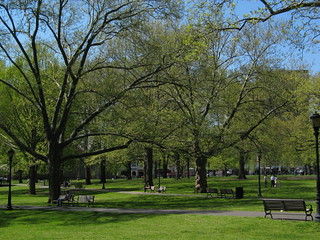 Bring various forms of green infrastructure into the city. Bring nature into the city in its many forms, from street trees to green squares, pocket parks to rain-gardens that treat stormwater runoff, flowers and ornamental greenery to “daylighted” streams and improved river commons. These all gladden the heart, refresh the spirit, and provide respite from the summer heat.
Bring various forms of green infrastructure into the city. Bring nature into the city in its many forms, from street trees to green squares, pocket parks to rain-gardens that treat stormwater runoff, flowers and ornamental greenery to “daylighted” streams and improved river commons. These all gladden the heart, refresh the spirit, and provide respite from the summer heat. - Maintain and restore historic buildings. Historic buildings provide our collective memory of place. We managed to effectively wipe out enormous and valuable parts of our architectural and cultural heritage nationwide, from the 1950s through the 1990s. But there are still gems in San Jose that must be respected.
- Capitalize on the city’s existing bones. Beneath what we’ve done to many of our cities lies the beating heart of a still-living community, and the infrastructure that, with a few tweaks, can handle growth. Modify it, perhaps, but use it.
- Try to keep what’s working. If there is a distinct ethnic neighborhood, or groups of ethnic restaurants, or specialized businesses, celebrate them, market them, and try to keep them.
Finally, a note about the San Jose/Santa Clara metro area and a ranking of ‘Best Performing Cities” recently released by the Milliken Institute (reported by Richard Florida in Atlantic Cities on April 29). San Jose came out on top of this index in 2012 (though it curiously ranked 51 the previous year). Although San Jose has significant problems to solve, I think the current high ranking, at least, is explainable. First, Milliken conflates the term “cities” with what are really metropolitan regions – and we know that the metropolitan region around and including Silicon Valley is performing very well, indeed. Second, according to a good recent analysis by Florida and his colleagues, both education levels and the amount of scientific and technical employment are very important to the index – and of course there are both, at high levels, in and about Santa Clara County. In my view, the ranking shouldn’t obscure the fact that San Jose probably needs to confront its challenges sooner, rather than later.
Again, I don’t pretend to have studied San Jose in depth, so I cannot presume to offer detailed or carefully considered advice. But I believe these are important points for places like San Jose: changing communities with potential, where economic growth is still taking place, but whose identity and economy has been significantly diffused or diluted and for which a more focused and hopeful future is desired.
More articles by Lee Epstein:
- The essential elements of green cities (April 3, 2013)
- Meet the nation's biggest landlord (and developer) (February 6, 2013)
- Could Buenos Aires be a model for thinking about US cities? (January 10, 2013)
- Sandy as preview: making communities more resilient to severe climate events (November 5, 2012)
- Getting to yes on the right kind of suburban change (October 9, 2012)
- The fall - and rise - of small downtown America (September 7, 2012)
Move your cursor over the images for credit information.
